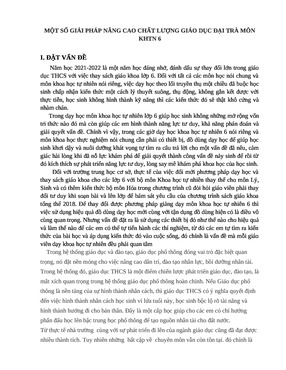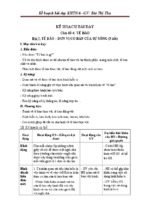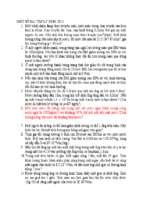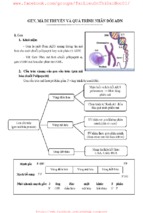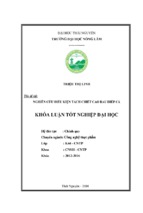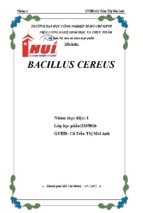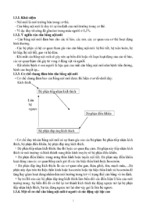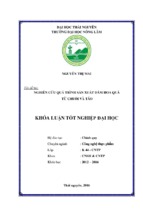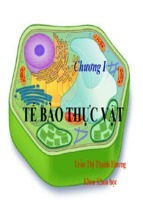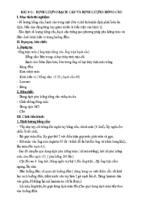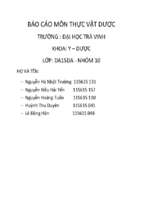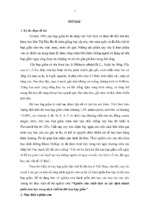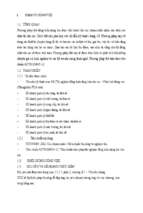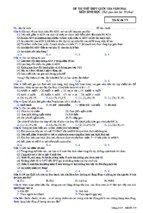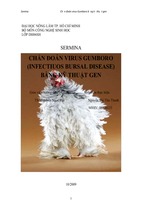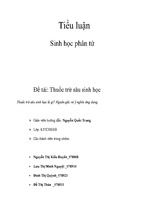APPLIED AND ENVIRONMENTAL MICROBIOLOGY, May 2002, p. 2344–2352
0099-2240/02/$04.00⫹0 DOI: 10.1128/AEM.68.5.2344–2352.2002
Copyright © 2002, American Society for Microbiology. All Rights Reserved.
Vol. 68, No. 5
Bacillus Probiotics: Spore Germination in the Gastrointestinal Tract
Gabriella Casula and Simon M. Cutting*
School of Biological Sciences, Royal Holloway University of London, Egham, Surrey TW20 0EX, United Kingdom
Received 4 September 2001/Accepted 14 February 2002
Spores of Bacillus species are being used commercially as probiotics and competitive exclusion agents. Unlike
the more commonly used Lactobacillus-type probiotics, spores are dormant life forms. To address how spore
probiotics might function we have investigated whether spores can germinate in the gastrointestinal tract by
using a murine model. Using a genetically engineered chimeric gene, ftsH-lacZ, which is strongly expressed only
in vegetative cells, we have developed a sensitive competitive reverse transcription-PCR assay which has
enabled detection of as few as 102 vegetative bacteria in the mouse gut. Using this method we have administered
doses of ftsH-lacZ spores to groups of mice and shown that spores can germinate in significant numbers in the
jejunum and ileum. The levels of detection we obtained suggest that spores may colonize the small intestine,
albeit briefly.
nal tract by pathogenic bacteria. There are three basic ways (8,
9, 26) in which this might be achieved: (i) immune exclusion of
a pathogenic bacterium, (ii) exclusion of a pathogen by competitive adhesion, and (iii) synthesis of antimicrobial substances which impair colonization of the gastrointestinal tract
by a pathogen. In recent work we have shown that spores of B.
subtilis do appear to have the potential to suppress all aspects
of Escherichia coli 078:K80 infection in a 1-day-old-chick
model (16). By analyzing spore counts in the feces of mice
administered spore suspensions, we have also shown that it is
possible that spores could germinate in the gastrointestinal
tract (15). If our hypothesis is correct then spores, by germinating, could function as a probiotic in the same way as the
conventional probiotic or CE bacteria. This has prompted the
work described here, in which we have developed a molecular
method to detect the germination of spores in the gastrointestinal tract of mice.
Bacterial spores are dormant life forms which can exist in a
desiccated and dehydrated state indefinitely. The process of
spore formation has been extensively studied as a simple model
for understanding cellular differentiation and is one of the
primary reasons for the interest in spores and spore formation
(7). Intriguingly though, spores of Bacillus subtilis are being
used as probiotics and competitive exclusion (CE) agents for
both human and animal consumption (18). For humans they
are available either as over-the-counter prophylactics for mild
gastrointestinal disorders such as diarrhea or as health foods or
nutritional supplements. In some countries though (e.g., Vietnam), bacterial spores are being used for oral bacteriotherapy
of gastrointestinal disorders often under clinical supervision.
In the agricultural industry spores are also receiving increasing
attention as potential alternatives to antibiotics as growth promoters. The use of probiotics and/or CE agents seems likely to
increase as public awareness of their potential benefits increases.
While spores are being sold as probiotics, an important
question is that of how spores act to enhance the normal
microbial flora of the gastrointestinal tract. This question must
be addressed, because the majority of probiotics currently
available are bacteria which are non-spore formers: i.e., they
are given as vegetative cells (usually as lyophilized preparations). The best-known examples of these probiotic bacteria
are the lactobacilli and bifidobacteria (2, 8, 9). If probiotic
bacteria are to be taken seriously then we would assume that
they would share a common mechanism for enhancing the
normal well-being of the gut microflora or for CE of potential
pathogens. If there is no common mechanism shared between
conventional Lactobacillus-type bacteria and the spore probiotics, then the question must be asked as to whether there is
any credibility to some of the claims made about the positive
benefits of probiotic bacteria (2, 12).
Probiotics and CE agents are thought to enhance the gut
microflora by preventing the colonization of the gastrointesti-
MATERIALS AND METHODS
Animals. Six-week-old, female, BALB/c mice were obtained from Harlan UK
(Oxon, United Kingdom) and maintained in animal facilities for the duration of
the experiment.
Strains. SC2288 (ftsH-lacZ) carries a transcriptional fusion of the 5⬘ segment
of the ftsH gene fused to the E. coli lacZ gene. This genetically engineered gene
carries resistance to chloramphenicol (final concentration of 5 g/ml) and has
been described elsewhere (17).
General methods. Bacillus and general molecular biology methods were as
described elsewhere (13, 22). DNA sequencing was performed using a commercial automated DNA sequencing facility (MWG Biotech, Ltd., Milton Keynes,
United Kingdom).
Preparation of spore or vegetative cells. (i) Spores. Spores were prepared from
large culture volumes (200 ml) using Difco sporulation medium (without antibiotics). This was the exhaustion method for induction of sporulation, and the
methodology has been reported in detail elsewhere (21). Spores were harvested
24 h after the estimated start of sporulation and treated with lysozyme to destroy
any residual vegetative cells as described (21). Spores were then washed repeatedly with water, concentrated by centrifugation, and heat treated at 65°C (45
min) to kill any residual vegetative cells or germinated spores. Aliquots were
frozen at known concentrations (CFU per milliliter) at ⫺80°C till use.
(ii) Vegetative cells. To prepare vegetative cells of SC2288 a single colony from
a Difco sporulation medium agar plate containing chloramphenicol at 5 g/ml
was used to inoculate 5 ml of Luria-Bertani (LB) broth containing 0.2% Lglutamine and 5% D-glucose. L-Glutamine and D-glucose were incorporated to
inhibit spore formation in LB growth (23). The culture was incubated at 30°C for
18 h in a roller drum. Three milliliters of this culture was used to inoculate 300
ml of LB broth (in a 2-liter flask) containing 0.2% L-glutamine and 5% D-glucose,
* Corresponding author. Mailing address: School of Biological Sciences, Royal Holloway University of London, Egham, Surrey TW20
0EX, United Kingdom. Phone: 44-(0)1784-443760. Fax: 44-(0)1784434326. E-mail:
[email protected].
2344
VOL. 68, 2002
SPORE GERMINATION
2345
FIG. 1. ftsH-lacZ chimera and PCR amplification products. (A) Physical map of the ftsH-lacZ chromosome of strain SC2288 as described by
Lysenko et al. (17). The FtsHdc and RlacZdc primers used to amplify a 509-base segment across the ftsH-lacZ fusion junction and FT2dc and
RlacZdc used to amplify a 453-base competitor template are shown together with the predicted amplification products. The hatched boxes indicate
the sequence included in the 5⬘ end of the FT2dc primer that is recognized by the FtsHdc primer. (B) PCR amplifications with these primer sets
using SC2288 chromosomal DNA. Lane M, 1-kb ladder.
and the culture was incubated at 37°C. When the culture had reached an optical
density at 600 nm (OD600) of approximately 0.6, cells were harvested and suspended in 0.1 volume of sterile 12% glycerol. The number of CFU per milliliter
of the suspension was then determined, and aliquots were frozen at ⫺80°C.
Intragastric dosing and dissections. Groups of mice were inoculated intragastrically with 0.2-ml suspensions of spores or vegetative cells using a ball-ended
feeding needle. Mice were dissected following sacrifice, and sections of the small
intestine (duodenum, jejunum, and ileum) or individual sections were excised
and processed immediately.
Analysis of spore shedding. Analysis of spore shedding was done as described
previously (15) using mice housed in individual cages with gridded floors to
prevent coprophagia.
Total RNA isolation. Total RNA from gut sections was isolated using TRIzol
based on the method of Chomczynski and Sacchi (4) as follows. Excised intestinal sections were homogenized in TRIzol (Life Technologies). Tissue was
weighed and immersed in TRIzol (3 ml) immediately following dissection. Acidwashed glass beads (1.5 ml; bead diameter, 0.5 mm) were added, and the samples
were frozen at ⫺80°C until the RNA isolation step. Complete lysis of the gut
tissue and disruption of the bacterial cells were achieved by vortexing the sample
containing the glass beads for 3 min followed first by sonication for 20 s (on ice)
and then by three cycles of freeze-thaw on dry ice. Homogenates were then
clarified by centrifugation (12, 000 ⫻ g, 10 min, 4°C), and the supernatant was
decanted and extracted with 0.9 ml of chloroform to destroy residual protein.
RNA was precipitated with ethanol following the manufacturer’s protocol, and
total RNAs were dissolved in 100 l of RNase-free water containing recombinant RNasin (1 U/l; Promega) and stored at ⫺80°C until reverse transcription
(RT)-PCR analysis. Total RNAs were quantified spectrophotometrically by
OD260 (GeneQuant II; Pharmacia). Prior to RT-PCR total RNAs were treated
with RQ1 RNase-free DNase (1 U/g of total RNA; Promega) for 45 min at
37°C, and the reaction was stopped by addition of 1 l of 20 mM EGTA and
DNase heat inactivated for 10 min at 65°C.
Primers. Detection of the ftsH-lacZ transcript was carried out using the primers FtsHdc (5⬘ CGCAAGAAACAAGCGGATGGG 3⬘; anneals to nucleotides
[nt] 307 to 326 of the ftsH open reading frame [ORF]) and RlacZdc (5⬘-ATCA
ACATTAAATGTGAGCGAG-3⬘; anneals to nt 366 to 386 of the lacZ ORF) to
amplify a product of 509 bp. For synthesis of the competitor template Ft2dc was
used as the 5⬘ primer (5⬘ CGCAAGAAACAAGCGGATGGGCCTGCTCAAT
CAGGCTCAAGGC 3⬘) together with RlacZdc to amplify a product of 453 bp
using SC2288 chromosomal DNA as a template. The underlined sequence is the
5⬘ sequence also present in FtsHdc. For establishing the quality of total mouse
RNA, mouse-specific -actin primers Act-F (5⬘ GCTGGTCGTCGACAACG
GCTCC 3⬘; anneals to nt 101 to 122 of the -actin ORF [accession no. X03672])
and Act-R (5⬘ GAGGATGCGGCAGTGGCCATCT 3⬘; anneals to nt 757 to
779 of the -actin ORF) were used to amplify a sequence of 679 bases.
Competitive RT-PCR assay. Our assay was based on the studies of Shin et al.
(24) and used the chimeric ftsH-lacZ gene containing the 5⬘ region (734 bp) of
ftsH fused to the lacZ gene of E. coli (Fig. 1). This hybrid gene has been
described previously (17) and is only expressed during vegetative cell growth
controlled from the A-recognized ftsH promoter. Spores of SC2288 (ftsH-lacZ)
were prepared as described above and used to dose multiple groups of four mice
orally (0.2-ml suspension containing 2 ⫻ 108 CFU/ml). At appropriate time
points thereafter one group was sacrificed, gut sections were dissected, and total
RNA (mouse and bacterial) was extracted.
For the assay a standard RT-PCR was performed on the total RNA samples
obtained from mouse sections using the two primers, FtsHdc and RlacZdc (Fig.
1), to amplify the 509-base product extending from ftsH to lacZ. A product would
only be detected if vegetative bacteria were present.
Next, to generate a competitive template we used the FT2dc and RlacZdc
primers (Fig. 1) to generate a smaller amplification product of 453 bases using
SC2288 chromosomal DNA as a template. FT2dc included a 5⬘ tail to which
FtsHdc could anneal. The competitive PCR product was gel purified, denatured,
and quantified (on the basis of OD260 determined using a Pharmacia Gene
Quant II device). A competitive RT-PCR was then performed as follows. First,
the competitive template was serially diluted and dilutions were mixed with a
known concentration of total RNA extract (1 g). Each PCR mixture therefore
consisted of two templates, various concentrations of competitive DNA, and a
fixed concentration of RNA. Next, in each PCR mixture, the primers FtsHdc and
RlacZdc were used to generate a PCR product of which two species should be
produced, a 453-base species amplified from the competitive template and a
509-base species amplified from the RNA template. The product of each PCR
was size fractionated by agarose gel electrophoresis (2% [wt/vol] acrylamide).
The dilution at which the 509- and 453-base PCR products were equivalent in
density enabled extrapolation of the number of moles of ftsH-lacZ mRNA by
regression analysis.
RT-PCR conditions. RT-PCRs were performed using the Calypso One-Step
RT-PCR system incorporating avian myeloblastosis virus (AMV) reverse transcriptase (DNAmp Ltd). The program conditions were 1 cycle at 50°C for 30 min
followed by 1 cycle at 94°C for 2 min (for inactivation of the reverse transcriptase); 10 cycles with annealing at 58°C for 30 s, extension at 68°C for 45 s, and
denaturation at 94°C for 20 s; a further 25 cycles with an extra cycle extension of
5 s per cycle; and a final extension at 68°C for 10 min.
To establish whether any DNA contamination had occurred samples were also
analyzed in parallel using heat inactivation of the reverse transcriptase at 95°C
for 5 min prior to amplification. As an internal control for RNA amplification,
positive control reagents in the Calypso RT-PCR kit, consisting of MS2 bacteriophage RNA and two primers, were used to obtain an amplification product of
1,054 bp.
Competitive RT-PCR regression analysis. Gel images were acquired using a
UVP imaging system and then analyzed by densitometry using Sigma Scan
software (Jandel Scientific). Densitometry data were subjected to regression
analysis, and the log number of the moles of competitor template was plotted
against the log ratio between the target product and the competitor band intensity. From the equimolar point of target and competitor product, the number of
moles of vegetative SC2288 mRNA can be calculated.
RESULTS
RT-PCR primers. We have used RT-PCR to develop a molecular method for the detection of spore germination in the
2346
CASULA AND CUTTING
APPL. ENVIRON. MICROBIOL.
TABLE 1. Shedding of B. subtilis spores in mouse fecesa
Time (h)
6
12
18
24
Total (% of inoculum)
Spore count in feces from mouse:
1
2
3
4
5.05 ⫻ 107
5.1 ⫻ 107
1.8 ⫻ 107
4.35 ⫻ 107
4.4 ⫻ 108
7.0 ⫻ 107
1.0 ⫻ 108
2.36 ⫻ 106
6.5 ⫻ 107
1.2 ⫻ 108
6.2 ⫻ 106
1.45 ⫻ 106
2.3 ⫻ 108
3.6 ⫻ 107
3.6 ⫻ 105
6.36 ⫻ 105
1.63 ⫻ 108 (27)
6.12 ⫻ 108 (102)
1.93 ⫻ 108 (32)
2.67 ⫻ 108 (44.5)
5
7.3 ⫻ 108
1.3 ⫻ 108
9.0 ⫻ 106
2.5 ⫻ 106
Mean spore
count (SD)
3.03 ⫻ 108
8.14 ⫻ 107
2.67 ⫻ 107
1.10 ⫻ 107
(2.86 ⫻ 108)
(4.17 ⫻ 107)
(4.15 ⫻ 107)
(1.87 ⫻ 107)
8.72 ⫻ 108 (145)
a
Individually housed mice (BALB/c, female, 6 weeks old) were orally given suspensions with 6 ⫻ 108 spores of SC2288 containing no viable vegetative bacteria. Total
feces were collected at 6-h time points using cages with gridded floors. Feces were then homogenized, heat treated at 65°C (45 min) to kill all vegetative bacteria, and
plated in serial dilution onto drug-resistant plates to estimate spore counts as described before (15). Individual spore counts for each mouse and time point are shown
together with the mean and standard deviation.
mouse gastrointestinal tract. Our work was based on the studies of Shin et al., who used competitive RT-PCR to quantify
the levels of respiratory syndrome virus in semen (24). In our
work we exploited a chimeric gene in which the ftsH gene of B.
subtilis has been fused to the lacZ gene of E. coli (17). The ftsH
gene is transcribed exclusively during vegetative cell growth by
RNA polymerase associated with A. ftsH was chosen since
this gene is expressed at high levels (6) which would increase
the probability for detection by RT-PCR. Cells carrying this
chimeric gene (strain SC2288) would produce a unique mRNA
transcript which could be detected by RT-PCR. In the first
instance we designed primer sets to amplify a defined segment
of the ftsH-lacZ transcript across the fusion junction of ftsH
and lacZ as shown in Fig. 1A. The first set of conventional PCR
primers (5⬘-FtsHdc and 3⬘-RlacZdc) was designed to amplify a
509-base segment. The second set used a modified 5⬘ primer
(5⬘-FT2dc) together with the same 3⬘ primer (RlacZdc) to
amplify a 453-base PCR product. The FT2dc primer carried a
5⬘ sequence to which FtsHdc could anneal and that would
enable the 453-base PCR product to be used as a competitive
template in our assay. As shown in Fig. 1B both primer sets
enabled the amplification of unique PCR products that could
be separated by agarose gel electrophoresis.
Transit of SC2288 spores in the mouse gut. To evaluate the
transit of SC2288 spores in the mouse gut we prepared spores
and dosed 5 mice with 6 ⫻ 108 spores. As well as lysozymetreating spore suspensions we also heat treated them (65°C, 45
min) to ensure the inactivation of all contaminating vegetative
cells. At 6-, 12-, 18- and 24-h intervals thereafter we collected
the total feces from individual mice and determined the number of spores present. As shown in Table 1 we found that for
two mice the total (cumulative) number of spores excreted was
greater than the original inoculum. We have observed this
previously and take this as evidence, although not proof, that
B. subtilis can colonize, albeit briefly, the mouse gut (15). Our
reasoning was that to account for the increased counts, spores
would have germinated, replicated and, for some, entered the
developmental pathway leading to the formation of spores.
Our data also showed that spore counts gradually dropped
over time yet considerable numbers of spores were detectable
at each time point. Accordingly, 6, 12, 18, and 24 h were chosen
as time points for sampling for RT-PCR analysis.
Optimization of RNA recovery from mouse gut tissue. Before attempting to evaluate the fate of spores administered
orally to mice we first established the parameters required to
recover high-quality RNA from the gastrointestinal tract and
then to establish the sensitivity of the RT-PCR using gut tissues spiked with vegetative B. subtilis. In the first instance we
evaluated a number of techniques as well as commercial kits
for isolating total RNA from excised sections of the gastrointestinal tract. The technique which we found reproducibly provided complete lysis and recovery of both mouse and bacterial
RNA was emulsion of tissues that had been spiked with vegetative B. subtilis cells in guanidinium thiocyanate (TRIzol)
followed by physical disruption with glass beads, sonication,
and repeated freeze-thaw cycles as described in Materials and
Methods. To determine the integrity of the extracted mRNA
we used RT-PCR primers that recognized the -actin gene.
Successful amplification of -actin produced a 679-base PCR
product which was found to be consistent between samples
(data not shown). Although not shown, formaldehyde agarose
gel electrophoresis was first used to determine the quality of
RNA prior to a RT-PCR.
Next, we performed experiments in which sections of the
small intestine were mixed with various amounts of vegetative
B. subtilis bacteria. Total RNA was then extracted, and RTPCR was used to amplify a cDNA product. This technique
enabled us to estimate the maximum sensitivity of our RTPCR method, i.e., the minimum number of SC2288 cells that
could be detected using RT-PCR. Figure 2 shows one experiment in which sections of jejunum have been spiked with
different amounts of SC2288 vegetative cells. Total RNA was
then prepared and RT-PCR was performed using the FtsHdc
and RlacZdc primers to amplify a 509-base cDNA product.
This experiment revealed a lower limit of detection of 104
cells/section (however, for the RT-PCR assay 0.01 volume was
used; therefore, the actual detection limit was as low as 102
cells). We have been unable to reliably detect a lower number
of bacteria using our methodology. These experiments have
also been repeated using spiked duodenum sections (data not
shown). As an important control we have found (data not
shown) that if mouse tissues are spiked with SC2288 spores no
RT-PCR product can be detected.
One further evaluation we performed was to use competitive
RT-PCR to quantify the number of ftsH-lacZ mRNAs in
spiked tissues (see Materials and Methods). This would, in
turn, enable an extrapolation of the number of vegetative cells.
Individual duodenum sections from six mice were spiked with
6 ⫻ 108 vegetative SC2288 cells. We used a competitive RTPCR assay (Fig. 3 shows a representative example from one
VOL. 68, 2002
SPORE GERMINATION
2347
inoculum of viable units (6 ⫻ 108) and in those from the 24-h
time point there were much lower levels (0.02 to 0.5%).
To add further support for these results we have repeated
this analysis using a different chimeric gene, rrn0-lacZ. Strain
SL6913 (obtained from P. Piggot) carries a transcriptional fusion of the rRNA gene, rrn0, to lacZ. This vegetative gene is
strongly expressed. We administered SL6913 spores (6 ⫻ 108)
to groups of four mice and used RT-PCR with appropriate
FIG. 2. Sensitivity of RT-PCRs. To approximate the sensitivity of
the RT-PCR small intestine sections excised from a mouse were spiked
with different amounts of vegetative cells of SC2288 (ftsH-lacZ) (see
Materials and Methods). Total RNA (1 g) was then prepared, and
RT-PCR was performed using FtsHdc and RlacZdc to amplify the
509-base ftsH-lacZ product. A positive control was also used to spike
mouse sections with MS2 phage and to amplify a 1,054-base MS2specific RT-PCR product of 1,054 bases. Lane 1, 5 ⫻ 107 SC2288 cells;
lane 2, 1 ⫻ 107 SC2288 cells; lane 3, 5 ⫻ 106 SC2288 cells; lane 4, 1 ⫻
106 SC2288 cells; lane 5, 5 ⫻ 105 SC2288 cells; lane 6, 1 ⫻ 105 SC2288
cells; lane 7, 5 ⫻ 104; lane 8, 1 ⫻ 104 SC2288 cells; lane 9, MS2 phage
(positive PCR control); lane M, 1-kb ladder.
sample) followed by regression analysis (shown as an average
for the group of six mice) to evaluate the number of moles of
ftsH-lacZ transcripts. The number of ftsH-lacZ mRNA moles
in 6 ⫻ 108 vegetative cells (i.e., equal to the intragastric inoculum) was found to correspond to 2.465 ⫻ 10⫺14 mol of RTPCR product, corresponding to 2.81 g (1.484 ⫻ 1010 copies)
of ftsH-lacZ mRNA.
Detection of germination in the small intestine. Groups of
mice were administered 6 ⫻ 108 spores of SC2288. Groups
were sacrificed at 6, 12, 18, and 24 h; sections of the small
intestine (duodenum and jejunum) were excised; and total
RNA was extracted. We used RT-PCR to first establish
whether ftsH-lacZ mRNA was present in samples from these
time points and from naïve mice. We failed to detect any signal
in duodenum samples at any time point but could readily
identify a PCR product in jejunum samples. The jejunum results are shown in Fig. 4 and reveal the strongest signals at the
18-h time point and weaker signals at 24 h. No signal could be
detected in samples from the 6- and 12-h time points. To
demonstrate that the signals we saw were due to ftsH-lacZ
mRNA and were not from DNA, Fig. 4 also shows the absence
of a signal in the 18- and 24-h samples in which the AMV
reverse transcriptase was heat inactivated prior to initiation of
cDNA synthesis. The only explanation for these results was
that spores of SC2288 had germinated in the small intestine.
To confirm that the RT-PCR products were indeed the correct
product we sequenced the amplification products in their entirety on both strands.
To quantify the signal strength we used a competitive RTPCR assay to establish the number of vegetative cells that
could produce this signal. The quantifications of the 18- and
24-h samples are shown in Fig. 5, and regression analysis is
shown in Fig. 6A and 6B. The results of the regression analysis
(Fig. 6C) revealed that in samples from the 18-h time point the
signals detected corresponded to 1 to 12% of the original
FIG. 3. Competitive RT-PCR assay. Determination of the number
of moles of ftsH-lacZ mRNA using a competitive RT-PCR assay.
Jejunum sections prepared from six mice were spiked with 6 ⫻ 108
vegetative cells of SC2288, and total RNA was prepared. RT-PCR was
used with two primers (FT2dc and RlacZdc) to generate a competitive
template of 453 bases. This competitor template was purified, and
dilutions were mixed with total RNA samples prepared from each
mouse. These were then used in individual RT-PCRs using primers
FtsHdc and RlacZdc to generate a 509-base product (from the RNA)
and a 453-base product (from the competitor). (A) Representative
titration from one mouse sample. As the concentration of competitor
template decreases so the production of the 509-base product increases (left to right on the gel). Relative absorbance values from
densitometric analysis of the 509- and 453-base PCR products were
determined and normalized for size. (B) Least-squares regression
analysis of average densitometric data from the group of six mice. The
log moles of competitor RT-PCR product is plotted against the logarithmic ratio of absorbance of the 509-base species to absorbance of
the 453-base product.
2348
CASULA AND CUTTING
APPL. ENVIRON. MICROBIOL.
FIG. 4. RT-PCR analysis of jejunum sections. Groups of four mice (lanes 1, 2, 3, and 4) were administered 6 ⫻ 108 spores of strain SC2288.
Mice were sacrificed at 6, 12, 18, and 24 h (B and C) and dissected, the jejunum was excised, and total RNA was extracted. (A) In addition naïve,
untreated mice and mice just before dosing (0 h) were also examined. Total RNA was subjected to RT-PCR analysis using two primers (FtsHdc
and RlacZdc) which generate a 509-base cDNA product if more than 104 SC2288 vegetative cells are present. Samples to the right of the 1-kb
ladder are identical RT-PCRs in which the AMV reverse transcriptase has been inactivated by heat treatment. (C) Control RT-PCR using MS2
bacteriophage as supplied with the Calypso RT-PCR kit.
primer sets to amplify a 1-kb PCR product in selected sections
of the small intestine. As shown in Fig. 7, we could obtain
signals from the 18- and 24-h samples of jejunum and from the
ileum sections from three mice as well.
DISCUSSION
We have developed a molecular method to demonstrate that
bacterial spores can germinate in the small intestine of mice.
Our reason for attempting this is to address the question of
how spore probiotics and CE agents currently consumed for
both human and animal use function. Our results show that
using a sensitive RT-PCR assay we can detect as few as 102
vegetative cells in the small intestine. Since our inoculum consisted only of spores, the one, and only, explanation for this
results is that spores had germinated. Considering that our
assay requires excision of tissues as well as breakage of bacteria
and mammalian tissues we believe this to be a significant
achievement. Spore germination was not detected in the duodenum but was readily detectable in the jejunum and in one
experiment was detected in the ileum as well. The sensitivity of
our method means that we cannot exclude the possible germination of spores in the duodenum, but this must be at very low
levels. The small intestine contains regions of different physiochemical conditions, and obviously the duodenum would carry
a high content of stomach acids as well as bile salts. These may
inhibit spore germination as predicted before (25) or contaminate our RT-PCR assay. We have also found that we could
detect the strongest germination signal in the sample from the
18-h time point. Analysis of the transit of spores through the
gut, in this work and elsewhere (14), has shown that the majority of spores are shed between 6 and 24 h in mice. It there-
VOL. 68, 2002
SPORE GERMINATION
2349
FIG. 5. Competitive RT-PCR analysis. Total RNA extracts from 18-h (A) and 24-h (B) jejunum samples of mice dosed with SC2288 (ftsH-lacZ)
cells were mixed with dilutions of a competitive template (as described in Materials and Methods and Fig. 3). Samples correspond to those of Fig.
4.
fore seems likely that germination is occurring during the first
24 h. In previous work we have shown that, following dosing of
mice with spores, counts can be detected in the feces as early
as 3 h (15).
We believe that our competitive RT-PCR assay is of sufficient accuracy to provide an estimate of the number of vegetative cells. However, we also realize that at a 10% level (the
level detected in one 18-h mouse section) when the original
inoculum was 6 ⫻ 108 cells, this would mean that in one section
of the gut, and for one window of time, 6 ⫻ 107 vegetative cells
are present. This is a remarkably high number considering the
original dose. We are sufficiently cautious about these quantifications not to try to make any definitive conclusions about
population size. However, if this estimate is correct, then a
significant number of vegetative cells must be present in the
small intestine, and we believe this would be more than could
be accounted for simply by germination of the original inoculum. A reasonable explanation then is that a percentage of
spores germinate and these then undergo limited rounds of
growth. This does not seem improbable, since B. subtilis has
been shown to grow under anaerobic conditions provided that
a suitable nutritional environment is available (20) (it is also
questionable whether the small intestine is completely anaerobic). Spores would be expected to germinate whether the
environment is aerobic or anaerobic, and the only necessary
condition is that suitable nutritional germinants (e.g., fructose,
L-alanine [19]) be present, and these should be present in the
small intestine. Supporting this, some spore-forming bacteria
have been shown to carry out their entire life cycle of sporulation and germination in the gastrointestinal tract of the
guinea pig (1), so there is no clear precedent for assuming that
spore formation or germination cannot occur in the intestinal
2350
CASULA AND CUTTING
APPL. ENVIRON. MICROBIOL.
FIG. 6. Quantitation of ftsH-lacZ transcripts. Densitometric analysis of the 453- and 509-base products from competitive RT-PCR assays shown
in Fig. 5 were used for regression analysis. Shown are results of regression analysis of the 18-h jejunum samples for the four mice sampled (A) and
the 24-h samples (B). (A) The equations for the regression lines relative to the 18-h samples were the following: mouse 1, y ⫽ ⫺0.8833x ⫺ 13.093
(R2 ⫽ 0.99); mouse 2, y ⫽ ⫺0.8961x ⫺ 13.982 (R2 ⫽ 0.99); mouse 3, y ⫽ ⫺0.9286x ⫺ 13.491 (R2 ⫽ 0.98); mouse 4, y ⫽ ⫺0.8897x ⫺ 12.989 (R2 ⫽
0.99). (B) The equations for the regression lines for the 24-h samples were the following: mouse 1, y ⫽ ⫺0.919x ⫺ 15.539 (R2⫽ 0.98); mouse 2,
y ⫽ ⫺0.9712x ⫺ 17.820 (R2⫽ 0.98); mouse 3, y ⫽ ⫺0.8786x ⫺ 118.107 (R2 ⫽ 1); mouse 4, y ⫽ ⫺0.9008x ⫺ 18.437 (R2 ⫽ 0.98). (C) Tabulation of
the quantification of vegetative bacteria (viable units) using the extrapolated regression data.
VOL. 68, 2002
SPORE GERMINATION
2351
FIG. 7. RT-PCR analysis using rrnO-lacZ. Groups of four mice were administered 6 ⫻ 108 spores of strain SL6913. Mice were sacrificed at 18
and 24 h and dissected, the jejunum and ileum were excised, and total RNA was extracted. Total RNA was subjected to RT-PCR analysis using
two primers which generate a 1-kb cDNA product when SL6913 vegetative cells are present.
tract. If vegetative cells of B. subtilis can exist in the small
intestine, then an interesting question is for how long and
whether they can colonize. As has been proposed previously B.
subtilis is sensitive to bile salts (25), and perhaps adverse conditions found in the small intestine eventually inhibit long-term
colonization. Interestingly though, studies using ligated ileum
loops from rabbits have suggested that spores might germinate
in the gastrointestinal tract (14).
If the small intestine can be colonized even briefly by vegetative B. subtilis, then this may provide a partial explanation for
how spores can be used, like the Lactobacillus species, as probiotics. That is, they would exert their beneficial effect as vegetative cells, and the fact that they are given as spores is simply
an effective means for delivering large quantities of bacteria to
the small intestine since the spore can survive transit across the
stomach. Interestingly, the Lactobacillus-type probiotics are
given as lyophilized preparations, and although this genus is
normally resident in the gut we would expect the majority of
these bacteria to be destroyed upon entry into the stomach.
The few that can survive would populate the small intestine
and somehow prevent colonization of the intestine by harmful
bacteria (i.e., by serving as a CE agent) and/or by enhancing
the gut microflora (as a probiotic). By analogy, delivery of a
high concentration of spores would enable almost 100% survival through the stomach, where a small population would
germinate, and the vegetative cells would briefly colonize one
or more sections of the small intestine. This is the model we
propose that could explain the apparent paradoxical use of
spores and Lactobacillus-type probiotics. For obvious reasons
we have used a murine model for these studies. It goes without
saying, then, that we cannot state that in a human, spores might
follow a similar pattern of germination and limited colonization. However, since B. subtilis is not a normal resident of
either the mouse gut or the human gut and spores are being
used as a probiotic or CE agent, it seems probable that delivery
of large numbers of this foreign bacterium will lead to germination and limited colonization.
Our work suggests that the small intestine is briefly colo-
nized by B. subtilis. However, it is also possible that the spore
itself exerts an immunostimulatory effect which serves to exclude the colonization of the gut by harmful pathogens. A
number of reports have shown that the spore is immunostimulatory and can elicit a number of cellular immune responses in
the gastrointestinal tract (3, 5, 10, 11). One final question our
work raises is that of the fate of vegetative B. subtilis. As
observed before (15) and also here (Table 1), on some occasions the number of excreted spores we can detect exceeds that
given in the original inoculum. Experimental error is of course
the immediate explanation, yet we have repeated these experiments many times and sometimes observe this increase. The
errors that would decrease the counts are the most probable,
and this then only supports the increase observed as being real.
We wonder, then, whether B. subtilis cells can sporulate in the
gut. The hostile conditions encountered, particularly as the
germinated cells enter the lower regions of the gastrointestinal
tract, make spore formation seem a likely escape route. Our
analysis of spore shedding here and in other work (15) has
shown that a small increase in spore numbers is found in the
feces 18 to 24 h after dosing. Taking into account our RT-PCR
analysis performed here, we propose that after 18 h significant
numbers of spores are germinating but the majority are shed in
the feces. Germinated spores will either be killed, perhaps by
the action of bile salts, or, after a few, limited rounds of growth
and division, form spores to escape the increasingly hostile
conditions found in the gut. Since spore formation in the laboratory takes a minimum of 7 to 8 h, we reason that spore
formation must be occurring simultaneously with spore germination at about 18 h and thereafter.
ACKNOWLEDGMENTS
We thank Dana Cohen for her assistance in the early part of this
study and Pat Piggot for the gift of SL6913.
This work was supported by grants from the Wellcome Trust and the
EU Vth Framework to S.M.C.
2352
CASULA AND CUTTING
REFERENCES
1. Angert, E. R., and R. M. Losick. 1998. Propagation by sporulation in the
guinea pig symbiont Metabacterium polyspora. Proc. Natl. Acad. Sci. USA
95:10218–10223.
2. Atlas, R. M. 1999. Probiotics: snake oil for the new millenium? Environ.
Microbiol. 1:375–382.
3. Caruso, A., G. Flamminio, S. Folghera, L. Peroni, I. Foresti, A. Balsari, and
A. Turano. 1993. Expression of activation markers on peripheral-blood lymphocytes following oral administration of Bacillus subtilis spores. Int. J. Immunopharmacol. 15:87–92.
4. Chomczynski, P., and N. Sacchi. 1987. Single step method of RNA isolation
by acid guanidinium thiocyanate-phenol-chloroform extraction. Anal. Biochem. 162:156–159.
5. Ciprandi, G., A. Scordamaglia, D. Venuti, M. Caria, and G. W. Canonica.
1986. In vitro effects of Bacillus subtilis on the immune response. Chemioterapia 5:404–407.
6. Deuerling, E., B. Paeslack, and W. Schumann. 1995. The ftsH gene of
Bacillus subtilis is transiently induced after osmotic and temperature upshift.
J. Bacteriol. 177:4105–4112.
7. Errington, J. 1993. Bacillus subtilis sporulation: regulation of gene expression
and control of morphogenesis. Microbiol. Rev. 57:1–33.
8. Fuller, R. 1991. Probiotics in human medicine. Gut 32:439–442.
9. Fuller, R. 1989. Probiotics in man and animals. J. Appl. Bacteriol. 66:365–
378.
10. Gialdroni-Grassi, G., and C. Grassi. 1985. Bacterial products as immunomodulating agents. Int. Arch. Allergy Appl. Immunol. 76:119–127.
11. Grasso, G., P. Migliaccio, C. Tanganelli, M. A. Brugo, and M. Muscettola.
1994. Restorative effect of Bacillus subtilis spores on interferon production in
aged mice. Ann. N. Y. Acad. Sci. 717:198–208.
12. Hamilton-Miller, J. M. T., and G. R. Gibson. 1999. Efficacy studies of
probiotics: a call for guidelines. Br. J. Nutr. 82:73–75.
13. Harwood, C. R., and S. M. Cutting (ed.). 1990. Molecular biological methods
for Bacillus. John Wiley & Sons Ltd., Chichester, United Kingdom.
APPL. ENVIRON. MICROBIOL.
14. Hisanga, S. 1980. Studies on the germination of genus Bacillus spores in
rabbit and canine intestines. J. Nagoya City Med. Assoc. 30:456–469.
15. Hoa, T. T., L. H. Duc, R. Isticato, L. Baccigalupi, E. Ricca, P. H. Van, and
S. M. Cutting. 2001. The fate and dissemination of Bacillus subtilis spores in
a murine model. Appl. Environ. Microbiol. 67:3819–3823.
16. La Ragione, R. M., G. Casula, S. M. Cutting, and S. M. Woodward. 2001.
Bacillus subtilis spores competitively exclude Escherichia coli 070:K80 in
poultry. Vet. Microbiol. 2062:133–142.
17. Lysenko, E., T. Ogura, and S. Cutting. 1997. Characterization of the ftsH
gene of Bacillus subtilis. Microbiology 143:971–978.
18. Mazza, P. 1994. The use of Bacillus subtilis as an antidiarrhoeal microorganism. Boll. Chim. Farm. 133:3–18.
19. Moir, A., and D. A. Smith. 1990. The genetics of bacterial spore germination.
Annu. Rev. Microbiol. 44:531–553.
20. Nakano, M. M., and P. Zuber. 1998. Anaerobic growth of a “strict aerobe”
(Bacillus subtilis). Annu. Rev. Microbiol. 52:165–190.
21. Nicholson, W. L., and P. Setlow. 1990. Sporulation, germination and outgrowth, p. 391–450. In C. R. Harwood and S. M. Cutting (ed.), Molecular
biological methods for Bacillus. John Wiley & Sons Ltd., Chichester, United
Kingdom.
22. Sambrook, J., E. F. Fritsch, and T. Maniatis. 1989. Molecular cloning: a
laboratory manual, 2nd ed. Cold Spring Harbor Laboratory, Cold Spring
Harbor, N.Y.
23. Schaeffer, P., J. Millet, and J. Aubert. 1965. Catabolic repression of bacterial
sporulation. Proc. Natl. Acad. Sci. USA 54:704–711.
24. Shin, J., E. M. Bautista, Y.-B. Kang, and T. W. Molitor. 1998. Quantitation
of porcine reproductive and respiratory syndrome virus RNA in semen by
single-tube reverse transcription-nested polymerase chain reaction. J. Virol.
Methods 72:67–79.
25. Spinosa, M. R., T. Braccini, E. Ricca, M. De Felice, L. Morelli, G. Pozzi, and
M. R. Oggioni. 2000. On the fate of ingested Bacillus spores. Res. Microbiol.
151:361–368.
26. Tannock, G. W. (ed.). 1999. Probiotics: a critical review. Horizon Scientific
Press, Norfolk, United Kingdom.

